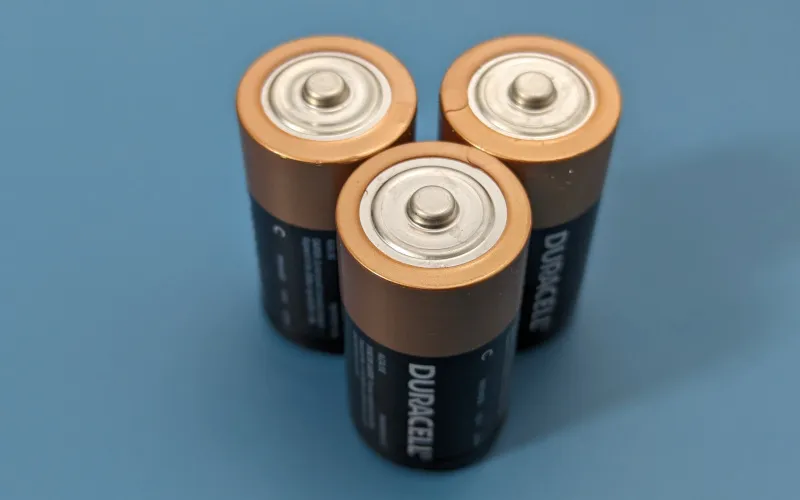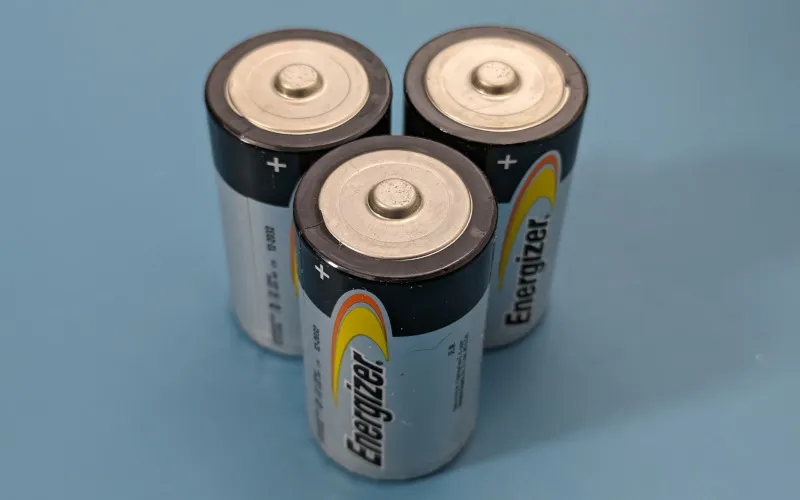C vs D Battery: What’s The Difference?
Batteries are a common energy source when it comes to powering devices. C and D batteries are frequently used in various sizes and types, especially in larger devices requiring more power.
Understanding the differences between these two battery types can help consumers make informed decisions based on their energy needs. This article will explore the key differences between C and D batteries in size, capacity, voltage, common uses, and rechargeability.
What are C and D Batteries?
C and D batteries are cylindrical dry cell batteries that differ primarily in size and power capacity. They are both part of the standard series of battery sizes defined by the American National Standards Institute (ANSI).
While they share some characteristics, they serve different purposes based on their energy storage capacities and physical dimensions.
Size and Physical Differences
The most noticeable difference between C and D batteries is their size. C batteries are smaller, typically measuring about 50 mm long and 26.2 mm in diameter.
This size makes them suitable for medium-sized devices that require a moderate amount of power. Despite their smaller size than D batteries, C batteries are larger than other common battery types, such as AA and AAA, allowing them to store more energy than their smaller counterparts.
On the other hand, D batteries are larger in length and diameter, measuring approximately 61.5 mm by 33 mm. This larger size allows for a greater volume of the chemical contents that produce electricity, leading to a longer lifespan and higher energy capacity.
D batteries’ increased size and capacity make them suitable for more energy-intensive applications.

Energy Capacity and Voltage
Both C and D batteries are designed to deliver a nominal voltage of 1.5 volts, standard for single-cell alkaline batteries. This voltage is consistent across many different sizes of batteries, making them interchangeable in terms of power output for devices that require a specific voltage level.
However, the key difference between the two lies in their energy capacity, measured in milliampere-hours (mAh). D batteries have a significantly higher capacity, typically 12,000 to 18,000 mAh, depending on the battery’s chemical composition and the manufacturer.
This higher capacity is due to the larger size and, consequently, a greater amount of chemical reactants.
In contrast, C batteries have a smaller capacity, usually between 6,000 to 8,000 mAh. While this is less than that of D batteries, it is still sufficient for powering medium-drain devices over extended periods.
The capacity of a battery determines how long it can provide power before needing replacement or recharging, affecting the user’s choice depending on their specific needs.

Chemical Composition
C and D batteries can be made from various chemical compositions, including alkaline, lithium, and rechargeable forms like nickel-metal hydride (NiMH) and nickel-cadmium (NiCd). Alkaline batteries are the most common due to their longer shelf life and lower cost.
They are suitable for various applications, from remote controls to portable radios.
Lithium batteries, while more expensive, offer a longer life and better performance, especially in extreme temperatures. They are also lighter, making them ideal for portable devices where weight is a concern.
Rechargeable C and D batteries, such as those made from NiMH and NiCd materials, provide an eco-friendly and cost-effective alternative to disposable batteries. They can be recharged hundreds of times, reducing waste and long-term costs.
However, they may have a lower voltage and energy capacity compared to their non-rechargeable counterparts and can lose charge when not in use.
Common Uses of C and D Batteries
C and D batteries are integral components in many household and professional devices. Their application varies widely, reflecting their capacity and size differences. Here’s a more detailed look into the common uses of these batteries:
C Batteries: Versatile Power for Medium-Drain Devices
C batteries are commonly found in devices that require a moderate amount of power. Due to their medium size and decent energy capacity, they are an ideal choice for a range of everyday applications:
- Portable Music Players and Radios: C batteries are often used in portable audio devices where they provide a balance between size and lasting power.
- Flashlights and Lanterns: They are suitable for medium-sized flashlights and lanterns, offering a reliable power source for extended periods, which is crucial in emergency situations or during outdoor activities.
- Toys and Games: Many children’s toys and electronic games require C batteries to function, as they provide enough power without the bulkiness of larger batteries.
- Musical Instruments: Some battery-operated musical instruments, such as electronic keyboards and percussion instruments, use C batteries for their portability and longevity.
- Medical Equipment: Certain medical devices, especially those that are portable and used in home settings, such as blood pressure monitors, rely on C batteries for consistent performance.
D Batteries: High-Energy Solutions for High-Drain Devices
D batteries, being larger, are tailored for high-drain applications where extended battery life is crucial. They are typically used in:
- Emergency Equipment: This includes large flashlights, safety equipment, and emergency response devices. Their longer life ensures these devices can be relied upon during critical situations.
- Portable Stereos and Boomboxes: These larger audio devices require extended energy D batteries to maintain volume and clarity over time.
- Industrial Tools: Some heavy-duty tools and construction equipment that are battery-operated might use D batteries for their ability to last longer under strenuous use.
- Outdoor Sporting Goods: Electric air pumps, camping lanterns, and portable heaters often use D batteries for their durability and extended life, making them ideal for outdoor activities.
- Large Toys and Ride-ons: Larger, motorized children’s toys, such as ride-on vehicles, may require D batteries due to their high energy needs.
Rechargeability of C and D Batteries
The concept of rechargeability in batteries has revolutionized how we use our devices, making it a crucial factor to consider when choosing between C and D batteries. Rechargeable batteries, known for their cost-effectiveness and environmental benefits, can be used multiple times before they need replacement.
Types of Rechargeable Batteries
C and D batteries come in rechargeable forms, typically Nickel-Metal hydrogen (NiMH) or Nickel-cadmium (NiCd) types. NiMH batteries are more common due to their higher capacity and lower environmental impact than NiCd batteries, which contain toxic cadmium.
New technologies like Lithium-Ion (Li-Ion) and Lithium Iron Phosphate (LiFePO4) are also available, offering higher efficiency and longer lifecycles but at a higher cost.
Benefits of Using Rechargeable Batteries
Rechargeable C and D batteries offer significant advantages over their disposable counterparts. Firstly, they are more cost-effective in the long run despite their higher initial price.
A single rechargeable battery can replace hundreds of disposable batteries. Secondly, they are environmentally friendly, reducing hazardous waste and conserving natural resources.
Thirdly, they provide consistent performance across their lifespan, which can be particularly beneficial for devices used frequently or for extended periods.
Lifecycle and Capacity
The lifecycle of rechargeable C and D batteries depends on their type and how they are used. Typically, NiMH batteries can be recharged up to 1000 times, while Li-Ion and LiFePO4 variants may last even longer.
However, their capacity, measured in milliampere-hours (mAh), can decrease over time and with each charge cycle. Proper care and maintenance can help maximize the lifespan and capacity of rechargeable batteries.
Maintenance and Care
Certain practices should be followed to maintain the health and extend the life of rechargeable C and D batteries. First, avoid overcharging and deep discharging, which can reduce battery life.
Use a smart charger that stops charging once the battery is full. Second, store batteries in a cool, dry place to prevent degradation.
Finally, regularly cycle (fully charge and then fully discharge) your batteries if they are not used frequently to keep them in optimal condition.
Making the Switch to Rechargeable Batteries
Switching to rechargeable C and D batteries can be smart for consumers who use devices requiring these sizes. While the upfront cost is higher, the long-term savings, environmental benefits, and convenience of a constant power source make them attractive.
When making the switch, consider the device’s energy requirements and usage patterns to choose the most suitable type and capacity of rechargeable battery.
How can I test the charge level of my C or D batteries using a multimeter?
Testing the charge level of C or D batteries using a multimeter is a straightforward process that can help you determine whether your batteries still hold enough charge for your devices or need replacing. Check out our article for testing C batteries with a multimeter.
Conclusion
Understanding the differences between C and D batteries, including size, capacity, and common uses, can help consumers choose the right battery type for their devices. While both provide the same voltage, D batteries offer a higher capacity and are better suited for high-drain devices.
Regardless of the type, proper disposal and consideration for rechargeable options can enhance environmental sustainability and cost-effectiveness.
Frequently Asked Questions
Can I use C batteries in place of D batteries?
It is possible to use C batteries instead of D batteries with the help of battery adapters. However, this may result in reduced performance or shorter battery life due to the lower capacity of C batteries.
Are C and D batteries alkaline or lithium?
Both C and D batteries can be found in alkaline and lithium versions. Alkaline batteries are more common and affordable, while lithium batteries provide longer life and better performance in extreme temperatures.
How do I dispose of C and D batteries?
Proper disposal of batteries is crucial for environmental safety. Both types should be recycled or disposed of according to local regulations. Many stores and community centers offer battery recycling services.

Author
Alex Klein is an electrical engineer with more than 15 years of expertise. He is the host of the Electro University YouTube channel, which has thousands of subscribers.
